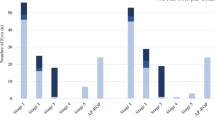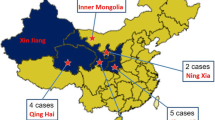Abstract
To describe the characteristics of infants with bilateral Stage 4b or 5 ROP (i.e. with subtotal or total retinal detachment) who presented to eye departments in two major cities in Mexico, to identify reasons why they may have become blind in order to recommend how programs could be improved. A large case-series of infants with Stage 4b or 5 ROP in both eyes confirmed by ultrasound who attended the ROP Clinic, Hospital Civil de Guadalajara from September 2010 to November 2012, and the Department of Ophthalmology, Hospital Infantil de Mexico Federico Gomez from December 2011 to December 2012 were identified from the diagnostic databases of each hospital. Mothers of infants in Guadalajara had a telephone interview. 89/94 eligible infants were included in the study, 48 in Guadalajara and 41 in Mexico City. Cases came from 22 of the 32 states in Mexico. Half of the infants attending Guadalajara 24/48 (50 %) had been cared for in NICUs without ROP screening programs and were not examined. Among the 24 infants cared for in NICUs with ROP programs, 7/24 (29.1 %) mothers reported that their infant had not been examined while in the NICU, and a further 9/24 (37.5 %) were either not referred for screening after discharge or they did not attend. Two infants had failed laser treatment. Strategies and resources to prevent end stage ROP have not been firmly established in Mexico. There is an urgent need to expand the coverage and quality of ROP programs, to ensure that existing screening guidelines are better adhered to, and to improve communication with parents.


Similar content being viewed by others
References
Gilbert, C. E., Fielder, A., Gordillo, L., Quinn, G., Semiglia, R., Vinsintin, P., et al. (2005). International No-ROP group characteristics of infants with severe retinopathy of prematurity in countries with low, moderate, and high levels of development: implications for screening programs. Pediatrics, 115, 518–525.
Blencowe, H., Lawn, J. E., Vazquez, T., Fielder, A., & Gilbert, C. (2013). Preterm-associated visual impairment and estimates of retinopathy of prematurity at regional and global levels for 2010. Pediatric Research, 74(Suppl 1), 35–49.
Born too soon: The global action report on preterm birth. Available at: http://www.who.int/pmnch/media/news/2012/borntoosoon_chapter2.pdf. Accessed 30 Sep 2013.
Gordillo, L., Villanueva, A. M., & Quinn, G. E. (2012). A practical method for reducing blindness due to retinopathy of prematurity in a developing country. Journal of Perinatal Medicine, 40, 577–582.
Quinn, G. E., Gilbert, C. E., Darlow, B. A., & Zin, A. (2010). Retinopathy of prematurity: An epidemic in the making. Chinese Medical Journal (England), 123, 2929–2937.
Darlow, B. A., Gilbert, C. E., & Quiroga, A. M. (2013). Setting up and improving retinopathy of prematurity programs: Interaction of neonatology, nursing, and ophthalmology. Clinics in Perinatology, 40, 215–227.
Jalali, S., Anand, R., Kumar, H., Dogra, M. R., Azad, R., & Gopal, L. (2003). Programme planning and screening strategy in retinopathy of prematurity. Indian Journal of Ophthalmology, 51, 89–99.
Zepeda-Romero, L. C., Barrera de Leon, J. C., Camacho-Choza, C., Gonzalez Bernal, C., Camarena-Garcia, E., Diaz-Alatorre, C., et al. (2011). Retinopathy of prematurity as a major cause of severe visual impairment and blindness in children in schools for the blind in Guadalajara city, Mexico. The British Journal of Ophthalmology, 95(11), 1502–1505.
Zin, A. A., Moreira, M. E., Bunce, C., Darlow, B. A., Gilbert, C. E., et al. (2010). Retinopathy of prematurity in 7 neonatal units in Rio de Janeiro: Screening criteria and workload implications. Pediatrics, 126, e410–e417.
Henderson, M. T., Wang, S. K., & Moshfeghi, D. M. (2013). A new paradigm for incorporating the joint statement screening guidelines for retinopathy of prematurity into clinical practice: Outcomes from a quaternary referral program. Ophthalmic Surgery Lasers and Imaging Retina, 44, 442–447.
Good, W. V. (2004). Early treatment for retinopathy of prematurity cooperative group. Final results of the early treatment for retinopathy of prematurity (ETROP) randomized trial. Transactions of the American Ophthalmological Society, 102, 233–250.
Palmer, E. A., Hardy, R. J., Dobson, V., Phelps, D. L., Quinn, G. E., & Summer, C. G. (2005). 15-year outcomes following threshold retinopathy of prematurity: Final results from the multicenter trial of cryotherapy for retinopathy of prematurity. Archives of Ophthalmology, 123, 311–318.
Manejo de la Retinopatía del Recién Nacido Prematuro. Lineamiento Técnico. México 2010. ISBN - 978-970-721-441-5. Available at: http://www.v2020la.org/docs/lineamiento/Lineamiento-ROP-SSA-2007.pdf. Data Accessed 2 July 2014.
Gilbert, C. E., Fielder, A., Gordillo, L., Quinn, G. E., Semiglia, R., Vinsintin, P., et al. (2005). Characteristics of infants with severe retinopathy of prematurity in countries with low, moderate, and high levels of development: implications for screening programs. Pediatrics, 115, e518–e525.
Diario Oficial de la Federación, Available at: http://www.dof.gob.mx/nota_detalle.php?codigo=5285817&fecha=25/01/2013. Data Accessed 15 June 2014.
Darlow, B. A., Ells, A. L., Gilbert, C. E., Gole, G. A., Quinn, G. E., et al. (2013). Are we there yet? Bevacizumab therapy for retinopathy of prematurity. Archives of Disease in Childhood. Fetal and Neonatal Edition, 98, F170–F174.
Zepeda-Romero, L. C., Liera-Garcia, J. A., Gutiérrez-Padilla, J. A., Valtierra-Santiago, C. I., & Avila-Gómez, C. D. (2010). Paradoxical vascular-fibrotic reaction after intravitreal bevacizumab for retinopathy of prematurity. Eye (London), 24, 931–933.
Gutiérrez, J. P., & Hernández-Ávila, M. (2013). Cobertura de protección en salud y perfil de la población sin protección en México, 2000–2012. Salud Publica de Mexico, 55(2), S83–S90.
Profit, J., Lee, D., Zupancic, J. A., Papile, L., Gutierrez, C., Goldie, S. J., et al. (2010). Clinical benefits, costs, and cost-effectiveness of neonatal intensive care in Mexico. PLoS Medicine, 7(12), e1000379.
Yang, M. B., Donovan, E. F., & Wagge, J. R. (2006). Race, gender, and clinical risk index for babies (CRIB) score as predictors of severe retinopathy of prematurity. Journal of American Association for Pediatric Ophthalmology and Strabismus, 10, 253–261.
Shah, P. K., Narendran, V., Kalpana, N., & Tawansy, K. A. (2009). Anatomical and visual outcome of stages 4 and 5 retinopathy of prematurity. Eye (London), 23, 176–180.
Bhende, P., Gopal, L., Sharma, T., Verma, A., & Biswas, R. K. (2009). Functional and anatomical outcomes after primary lens-sparing pars plana vitrectomy for Stage 4 retinopathy of prematurity. Indian Journal of Ophthalmology, 57, 267–271.
Cusick, M., Charles, M. K., Agrón, E., Sangiovanni, J. P., Ferris, F. L, 3rd, & Charles, S. (2006). Anatomical and visual results of vitreoretinal surgery for stage 5 retinopathy of prematurity. Retina, 26, 729–735.
Urrets-Zavalia, J. A., Crim, N., Knoll, E. G., Esposito, F. A., Collino, E., Urrets-Zavalia, M. E., et al. (2012). Impact of changing oxygenation policies on retinopathy of prematurity in a neonatal unit in Argentina. British Journal of Ophthalmology, 96, 1456–1461.
INEGI resultados de encuesta nacional de ocupacion y empleo. www.inegi.org.mx/inegi/contenidos/espanol/prensa/comunicados/estrucbo/pdf.
Yanovitch, T. L., Siatkowski, R. M., McCaffree, M., & Corff, K. E. (2006). Retinopathy of prematurity in infants with birth weight > or = 1250 grams-incidence, severity, and screening guideline cost-analysis. Journal of American Association for Pediatric Ophthalmology and Strabismus, 10(2), 128–134.
Kamholz, K. L., Cole, C. H., Gray, J. E., & Zupancic, J. A. (2009). Cost-effectiveness of early treatment for retinopathy of prematurity. Pediatrics, 123(1), 262–269.
Brown, G. C., Brown, M. M., Sharma, S., Tasman, W., & Brown, H. C. (1999). Cost-effectiveness of treatment for threshold retinopathy of prematurity. Pediatrics, 104(4), e47.
Dunbar, J. A., Hsu, V., Christensen, M., Black, B., Williams, P., & Beauchamp, G. (2009). Cost-utility analysis of screening and laser treatment of retinopathy of prematurity. Journal of American Association for Pediatric Ophthalmology and Strabismus, 13(2), 186–190.
Zin, A., Magluta, C., Pinto, M., Entringer, A., de Sousa Mendes Gomes, M., Lopes Moreira, M., & Gilbert, C. (2014). Retinopathy of prematurity screening and treatment cost in Brazil. Revista Panamericana de Salud Pública = Pan American Journal of Public Health, 36(1), 37–43.
Vinekar, A., Gilbert, C. E., Dogra, M., Kurian, M., Shainesh, G., Shetty, B., et al. (2014). The KIDROP model of combining strategies for providing retinopathy of prematurity screening in underserved areas in India using wide-field imaging, tele-medicine, non-physician graders and smart phone reporting. Indian Journal of Ophthalmology, 62, 41–49.
Quinn, G. E., Ying, G. S., Daniel, E., Hildebrand, P. L., Ells, A., Baumritter, A., et al. (2014). Validity of a telemedicine system for the evaluation of acute-phase retinopathy of prematurity. JAMA Ophthalmology,. doi:10.1001/jamaophthalmol.2014.1604.
Fijalkowski, N., Zheng, L. L., Henderson, M. T., Wallenstein, M. B., Leng, T., Moshfeghi, D. M., et al. (2013). Stanford university network for diagnosis of retinopathy of prematurity (SUNDROP): Four-years of screening with telemedicine. Current Eye Research, 38, 283–291.
Photographic Screening for Retinopathy of Prematurity (Photo-ROP) Cooperative Group, Balasubramanian, M., Capone, A, Jr, et al. (2006). The photographic screening for retinopathy of prematurity study (Photo-ROP): Study design and baseline characteristics of enrolled patients. Retina, 26, S4–S10.
Trese, M. T. (2008). What is the real gold standard for ROP screening? Retina, 28, S1–S2.
Conflict of interest
None.
Author information
Authors and Affiliations
Corresponding author
Rights and permissions
About this article
Cite this article
Zepeda-Romero, L.C., Meza-Anguiano, A., Barrera-de León, J.C. et al. Case Series of Infants Presenting with End Stage Retinopathy of Prematurity to Two Tertiary Eye Care Facilities in Mexico: Underlying Reasons for Late Presentation. Matern Child Health J 19, 1417–1425 (2015). https://doi.org/10.1007/s10995-014-1648-z
Published:
Issue Date:
DOI: https://doi.org/10.1007/s10995-014-1648-z




